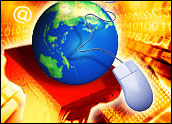
The explosive growth of smartphone and tablet devices may have gotten the mouse running scared. That’s the kind with buttons and scroll wheel — not the tailed, furry variety that elephants are afraid of.
How long has the mouse got?
Dire Predictions
Way back in the dark slate ages of 2008, Gartner analyst Steve Prentice made a startling prophecy based on his observations at that year’s CES of multiple computer interfaces that used gestures and other interactions, rather than common keyboard and mouse.
It was the beginning of the end for the familiar I/O devices, he predicted, and they would die within a few years.
Reading his pre-touchscreen, mouse-less prophecy some years later, as I leave finger marks all over my tablet, while my mouse and keyboard are on a desk way over on the other side of the room, it is clear this distinguished Gartner research fellow may have been right.
Hover and Swipe
“When I wrote about the demise of the mouse back in 2008, we still had not seen the explosion of touchscreen mobile devices, and multitouch that we have today,” Prentice said.
“We have the rise of touch and multitouch, and the predominance of mobile and handheld devices. Notebooks outsell desktops today, and mobile devices outsell computers by four or five times. Hence the mouse is definitely into the long tail period, if you can excuse the pun,” Prentice said.
“Just watch people pick up a device, and they assume it is touch-sensitive,” he pointed out. “Essentially, touch capability is assumed for any handheld device today. We already have the technology to control computers without physical touch — think Microsoft Kinect.”
Leap Motion is promising a gesture sensor that will give sub-millimeter accuracy for finger movements. It’s expected to be available by the end of the year at a cost of around US$100.
“That is a critical price point, and the accuracy enables a whole range of new options. I think we will see, over the next few years, touch and swipe being replaced by hover and swipe,” said Prentice.
Touch will also take off at the PC level, according to Linn Huang, an analyst at IDC.
“Out of all of the new interfaces, touch is the most logical choice,” Huang said.
By 2016 over 50 percent of portable PCs will be touch, and that number doesn’t include tablets, IDC forecast.
Nuanced Gestures
Leap Motion’s nuance-oriented gesture sensor product is better than a mouse or touch screen, claimed CEO Michael Buckwald.
“Traditional keyboard-and-mouse navigation has limited our ability to harness today’s powerful computers. The ability to control any computer with nuanced hand and finger movements will fundamentally transform the way people interact with computers,” he said.
“Leap has a couple of advantages over tablets and touchscreens,” continued Buckwald. “First, tablets and touchscreens are limited to two dimensions, while Leap allows you to interact in 3-D space.
“Second, Leap allows you to efficiently navigate the whole screen with small movements. Touchscreens work well on smaller devices, but as the screen size increases, touch becomes less efficient,” he said.
An action like pinch-to-zoom, for example, is easy on a small scale, but difficult on a 30-inch screen, Buckwald pointed out. “Leap allows you to use natural hand and finger gestures that don’t lead to fatigue in the way larger hand and arm movements do.”
Consumption vs. Creation
There’s a prevalence of consumption versus creation today, and it affects I/O.
The days of the keyboard are numbered, in Prentice’s view. “We are moving inexorably towards a situation where content consumption dominates over content creation. People use devices to read books, watch movies, play games and a myriad of other tasks — rarely to write letters and reports.”
There are exceptions, of course — myself and himself, for example.
However, “the QWERTY keyboard is a throwback to another era,” he maintained.”Many kids type faster on a mobile phone with predictive text than they can on a traditional keyboard. So alongside the mouse, I think the physical QWERTY keyboard should start considering itself under notice. It will be another long tail — they will not disappear altogether, but the typing is on the wall, as it were.”
Touch will become critical in the PC ecosystem, but it won’t kill the mouse and keyboard, maintained Huang. “With critical tasks, people will still go back to the keyboard.”
For one thing, a clamshell notebook screen is physically tilted, compared to the touchscreen on a tablet, and that configuration requires different interactions.
And where’s it going from here?
A key factor is Microsoft embracing touch in its latest PC-based OS, the soon to be released Windows 8, Huang said. “With Windows 8 this Q4 holiday, touch … is being given the chance to become a mainstream interface.”
However, there is one market-related concern. Windows 8 touch products might be too expensive for many consumers to handle, due to Microsoft’s high specification demands on hardware makers, he noted.
We’ll ultimately end up with new form factors that will change everything, Prentice predicted. “We will see a growing move towards wearable devices over the next five years. Think Google Glass, rather than the iPhone.
“Once the form factor is broken, then imagination takes off, and we enter a new era of communications which is not dependent on a physical, recognizable device,” he said.
I’ll check back in another five years to find out if Prentice was right.





















































